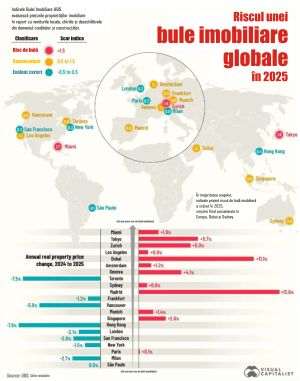Achieving a sustainable economy and reaching some targets of the Green Deal have the support of the banking system in our country, which in recent years has introduced several green credit products, even if the interest rates charged on some of them are quite high. Local banks have launched financial products dedicated to supporting green investments, whether we're talking about energy-efficient homes or the purchase of environmentally friendly equipment. Green loans granted by banks operating in our country have interest rates between 5.3% and 15.4%, depending on their type and the amount of financing granted, and most of them do not involve the creation of guarantees.
Green credit is a banking product intended to finance projects that have a positive impact on the environment. This can include mortgage loans for green homes, personal loans for the purchase of energy-efficient equipment (such as photovoltaic panels) or other products dedicated to reducing the carbon footprint.
According to the data posted on the website of the banks in our country, there are a variety of green loans for individuals and legal entities, and among them are, for example, the following:
1. BCR (Romanian Commercial Bank)
- Casa Mea NaturA is a mortgage loan intended for the purchase of ecological housing. It comes with preferential interest rates for those who choose energy efficient homes and offers advantageous terms for those who want to adopt a more environmentally friendly lifestyle.
- The credit for prosumers is a financing line intended for the purchase of photovoltaic panels. Thus, customers can become prosumers, i.e. they can produce and consume energy from renewable sources.
2. Raiffeisen Bank
- The Casa Ta Verde loan is a mortgage product offered to individuals who want an ecological home. Raiffeisen supports the purchase of homes that meet energy efficiency standards and reduce CO2 emissions.
- Raiffeisen also offers dedicated financing to SMEs for the purchase of green equipment, such as photovoltaic panels, thus encouraging the private sector to invest in sustainable solutions.
3. Banca Transilvania
- It recently launched a green personal needs loan, intended for the purchase of green products and services. Customers can use the funds to improve their homes from an energy point of view or to invest in technologies that reduce their energy consumption.
- In addition, BT supports companies through financing dedicated to the purchase of photovoltaic panels, contributing to a circular economy by supporting renewable energy.
4. BRD - Groupe Societe Generale
- The Expresso Verde loan is a loan for personal needs aimed at improving the energy efficiency of homes. It comes with favorable conditions for those who want to invest in green equipment.
- Green Habitat is a mortgage that offers additional advantages for those who purchase green homes with high energy efficiency.
5. CEC Bank
- The Casa Mea Verde Mortgage is aimed at people who want to purchase ecological homes, and the bank collaborates with the European Investment Bank Group to provide funds and guarantees for this type of purchases.
- CEC Bank also finances projects involving green procurement, offering additional support through partnerships with European institutions and through access to external financing.
6. Alpha Bank
- Offers a financing package called Alpha Housing - Green Offer, which is dedicated to those who want an environment-friendly home with increased energy efficiency. This initiative is in line with the bank's policies to support sustainability and reduce energy consumption.
• The advantages of green credit
The implementation of green credits by the banking system has multiple advantages, both for customers and for the economy and the environment. Significant benefits include:
- Reduced utility costs: Green homes, equipped with modern insulation and renewable energy production systems, can significantly reduce heating, cooling and lighting expenses.
- Reducing the carbon footprint: investments in green technologies such as photovoltaic panels directly contribute to the reduction of greenhouse gas emissions.
- Preferential interest rates and advantageous conditions: many banks offer low interest rates for green loans, thus encouraging responsible and sustainable consumption behaviors.
- Support for sustainable development: through green loans, banks contribute to the development of an economic environment in which sustainability and environmental responsibility become priorities.
• Challenges and Perspectives
Green lending, although it represents the future of financing by the banking sector, also faces some obstacles. These include:
- Lack of financial and environmental education: Many consumers are not fully informed about the economic and environmental benefits of green housing and equipment.
- High initial costs: Although these investments have long-term benefits, the initial costs may be an impediment for some individuals or companies.
- Low regulations and infrastructure: Another key factor is the development of the legislative framework to support green lending through subsidies, tax breaks or other forms of support.
However, as the banking system and financial institutions collaborate more closely with authorities and international partners, there are optimistic prospects for the growth of green lending in our country. European initiatives such as the Just Transition Fund can further contribute to supporting this green transition. This transition to a green economy not only improves the quality of life, but also ensures a robust financial framework adapted to today's climate challenges.























































